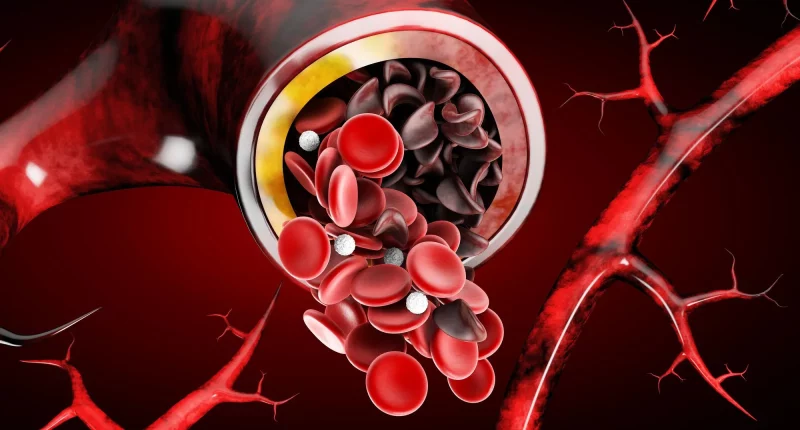Calciphylaxis is an uncommon and serious condition where too much calcium accumulates in the arteries and blood vessels. This calcium buildup can lead to blood clots and cause extremely painful skin sores.
This condition often affects people who have kidney disease. The seriousness of calciphylaxis can be high, meaning it can be very dangerous and even life-threatening.
If someone thinks they might have calciphylaxis, it’s important to see a healthcare provider right away. Early diagnosis and treatment are crucial for managing this condition effectively.
Symptoms of Calciphylaxis
Calciphylaxis can present with a range of symptoms, which might vary in severity from person to person. Common signs include various skin issues like discoloration, ulcers, and painful lesions. The condition leads to calcium accumulation in the arteries and blood vessels, which can result in cellulitis, the formation of bone in soft tissues, and even gangrene. Intense pain is another frequent symptom. In more severe cases, individuals might experience vision issues, muscle damage, and internal bleeding. Given the potentially severe nature of calciphylaxis, it can result in a high mortality rate if not properly managed.
Calciphylaxis often develops in individuals with kidney disease, which can sometimes go unnoticed in its early stages. When kidney disease progresses to its later stages, it may present with several symptoms, including significant weight loss and a loss of appetite. Patients may also experience swelling in the hands, feet, and ankles, along with breathing difficulties, extreme tiredness, and sleep problems such as insomnia. Other symptoms can include an increased need to urinate, blood in the urine, nausea, headaches, itchy skin, muscle cramps, and erectile malfunction.
Causes and Triggers
The exact cause of calciphylaxis is not fully understood, but it is generally linked to an accumulation of calcium in the blood vessels. This buildup often results from a disruption in the body’s ability to properly metabolize certain minerals. Researchers have noted that individuals who depend on dialysis, such as those with kidney disease, are particularly at risk. A study in 2018 indicates that these individuals often experience disruptions in mineral metabolism, which may contribute to the excessive calcium accumulation seen in calciphylaxis.
Risk Factors
Certain factors can increase the likelihood of developing calciphylaxis. Research indicates that women and individuals of Caucasian ethnicity may be at a higher risk. Additionally, people with specific medical conditions are more susceptible to this condition. These include kidney disease, diabetes, obesity, and hypoalbuminemia, which is characterized by low levels of albumin in the blood. Autoimmune disorders such as rheumatoid arthritis, lupus, and antiphospholipid antibody syndrome—an immune disorder linked to abnormal antibodies and potential blood clots—also contribute to the risk. Liver disease, cancer, and the duration of dialysis treatment (known as dialysis vintage) are other significant risk factors.
Certain medications can further increase the risk of calciphylaxis. These include corticosteroids, warfarin, activated vitamin D, calcium-based phosphate binders, and iron therapies. Advanced kidney failure is considered one of the most common reasons for getting calciphylaxis, affecting approximately 0.04 percent to 4 percent of dialysis patients.
Complications
Calciphylaxis can lead to several serious complications. One significant issue is intense pain caused by skin lesions and ulcers. These painful sores can limit a person’s mobility and overall quality of life. Additionally, the skin lesions associated with calciphylaxis may fail to heal properly, leading to infections. These infections are often due to open wounds and can impact the bloodstream, posing further health risks.
Another severe complication is sepsis, a condition where the body’s response to an infection causes widespread inflammation. This can damage tissues and organs, making sepsis a potentially life-threatening condition. Managing and addressing these complications is crucial for improving outcomes for individuals with calciphylaxis.
Diagnosis
If someone suspects they have calciphylaxis, it is crucial to consult a healthcare provider as soon as possible. The healthcare provider will typically start by reviewing the patient’s medical history, gathering detailed information about their symptoms, and conducting a physical examination. According to a study from 2019, a diagnosis of calciphylaxis may be considered if a patient with end-stage renal disease presents with skin ulcers.
Diagnostic Tool
To confirm the diagnosis, a biopsy of the skin lesions may be necessary to exclude other similar conditions. In some cases, a biopsy might be performed even if the person is in the renal disease early stages. However, biopsies may occasionally worsen the ulcers, leading to bleeding or infection, which is why some healthcare provider may choose to avoid this procedure if they are confident in their diagnosis. Additionally, blood tests can help assess calcium levels, and X-rays may reveal any calcium build-up in the body.
Treatment
Treating calciphylaxis involves a comprehensive approach, often needing coordination among specialists in dermatology, nephrology, pain management, and wound care. The primary goals of treatment are to optimize wound care, halt the progression of calcification of vessel walls, and potentially reverse existing calcification.
Medication
Cinacalcet, a medication initially used to manage high calcium levels in patients with hyperparathyroidism on long-term dialysis, is also employed in treating calciphylaxis. Hyperparathyroidism involves overactivity of the parathyroid glands. Cinacalcet is administered orally in tablet form and has shown a high response rate for calciphylaxis treatment, according to a 2019 study.
Another medication, sodium thiosulfate, is commonly used in the treatment of calciphylaxis, although it is not FDA-approved for this purpose. It is administered to about 50 percent of patients with calciphylaxis and can be given intravenously during dialysis sessions to help reduce calcium accumulation in the arteries.
Wound Care
Proper wound management is critical in treating calciphylaxis. Antibiotics may be prescribed to prevent infection, and wound dressings are applied as needed. Debridement, a procedure to eliminate dead tissue, may also be performed and occasionally involves surgical intervention.
Hyperbaric Oxygen Therapy
It can aid in wound healing by exposing the affected areas to oxygen at higher pressures than normal. A 2015 study found that this therapy benefited more than 50% of patients studied and suggested it could improve life expectancy.
Kidney Transplant
In some cases, a kidney transplant has been necessary for patients with calciphylaxis. Research highlights three case studies where individuals with the 5th stage of kidney failure received urgent transplants and successfully recovered from calciphylaxis post-surgery.
Outlook
The prognosis for calciphylaxis can be quite serious. The mortality rate is approximately 30% within six months and rises to about 50% within 12 months. Research indicates that blood poisoning or septicemia, resulting from wound infections, is the primary cause of death in individuals with calciphylaxis. Early diagnosis and prompt treatment are crucial for improving outcomes and potentially reducing the risk of severe complications.
Prevention
Preventing calciphylaxis, especially in individuals with the final stage of kidney disease, is challenging due to the limited preventive options available. Medical professionals focus on closely observing and managing calcium and mineral levels in patients with the final stage of kidney disease to mitigate the risk of calciphylaxis. Additionally, healthcare providers can play a role in educating patients about the condition and screening those at risk to help prevent its development.
Summary
Calciphylaxis is an uncommon and serious condition characterized by excessive calcium buildup in blood vessels, leading to painful skin lesions and potential complications like infections and sepsis. The risk factors include kidney disease, certain medications, and conditions such as obesity and diabetes. Diagnosis involves a thorough medical evaluation and may include biopsies, blood tests, and X-rays.
Treatment focuses on wound management, controlling calcium levels, and using medications like cinacalcet and sodium thiosulfate. The prognosis is poor, with high mortality rates, but early diagnosis and treatment can improve outcomes. Preventive measures are limited but include monitoring mineral levels and educating at-risk individuals.









